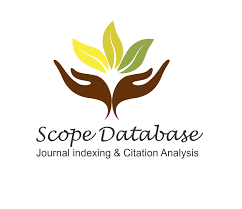Details
Sustainable Sericulture - A Pillar of Modern Agriculture
Pravallika N.B. R.
Dept of Biosciences and sericulture, MSc. Sericulture, Sri Padmavathi Women’s University, Tirupati, Andhra Pradesh
Mounika Saddala
Dept of Biosciences and sericulture, MSc. Sericulture, Sri Padmavathi Women’s University, Tirupati, Andhra Pradesh
Sushmitha Kale
Lecturer, Department of Sericulture, Government Degree College, Shadhnagar, Telangana
Ruchitha Mashetty
Department of Sericulture, MSc. Sericulture, University of Mysore, Mysuru, Karantaka
Download PDF http://doi.org/10.37648/ijrst.v15i03.002
http://doi.org/10.37648/ijrst.v15i03.002
Abstract
Sericulture serves as an additional livelihood option that supports eco-friendly agriculture. Mulberry cultivation enhances soil fertility, reduces erosion, and supports biodiversity within farming systems. Its integration with crops and agro forestry ensures efficient land use and resource conservation. Silkworm rearing provides regular supplementary income to farmers with minimal landholding. The enterprise generates rural employment, especially for women, improving livelihood security. By linking agriculture with silk production, it diversifies farm outputs and stabilizes rural economies. Overall, sericulture offers ecological, economic, and social benefits that make it a valuable component of sustainable farming.
Keywords: Eco-friendly practices; Climate resilience; Rural livelihood; Agricultural diversification; Income security; Sustainable farming systems Modern technology in sericulture
References
- Andadari, L., Yuniati, D., Supriyanto, B., et al. (2022). Lens on tropical sericulture development in Indonesia: Recent status and future directions for industry and social forestry. Insects, *13*(10), 913. https://doi.org/10.3390/insects13100913
- Babu, C. M., & Dandin, S. B. (2009). Organic farming for mulberry – An overview. Indian Journal of Sericulture, *48*, 100–110.
- Al-Abdullah, S., & Park, M. (2024). Wearable AI systems for cardiovascular monitoring. Sensors and Actuators B: Chemical, 438, 135861. https://doi.org/10.1016/j.snb.2024.135861
- Barman, B. K. (2001). Women in small-scale aquaculture in North-West Bangladesh. Gender, Technology and Development, *5*, 267–287. https://doi.org/10.1080/09718524.2001.11909994
- Bose, M. L., Ahmed, A., & Hossain, M. (2009). The role of gender in economic activities with special reference to women‘s participation and empowerment in rural Bangladesh. Gender, Technology and Development, *13*, 69–102. https://doi.org/10.1177/097185240901300104
- Buhroo, Z. I., Bhat, M. A., Malik, M. A., et al. (2018). Trends in development and utilization of sericulture resources for diversification and value addition. International Journal of Entomological Research, *61*, 27–47.
- Central Silk Board, Ministry of Textiles, Govt. of India. (2021). Functioning of Central Silk Board & Performance of Indian Silk Industry.
- Chand, S., & Raula, B. (2023). Usage of silkworm materials in various ground of science and research. Journal of Natural Fibers, *20*(1), 2139328. https://doi.org/10.1080/15440478.2022.2139328
- Chandrasekharan, K., Nataraju, B., Balavenkatasubbaiah, M., Sharma, S. D., Selvakumar, T., & Dandin, S. B. (2006). Grasserie and post cocoon mortality in silkworm. Indian Silk, *45*(4), 12–13.
- Chauhan, T. P. S., & Tayal, M. K. (2017). Mulberry sericulture. In Industrial entomology (pp. 197–263). Springer.
- Dandin, S. B., & Verma, S. (2002). Mechanization in sericulture – Need & scope. Indian Silk, *41*(1), 9–12.
- Das, P. K., Bhogesha, K., Sundareswaran, P., Madhana Rao, Y. R., & Sharma, D. D. (1997). Vermiculture: scope and potentiality in sericulture. Indian Silk, *36*(2), 23–26.
- Dhyani, S. K., Chauhan, D. S., Kumar, D., et al. (1996). Sericulture-based agroforestry systems for hilly areas of north-east India. Agroforestry Systems, *34*, 247–258. https://doi.org/10.1007/BF00046925
- Du, Z. H., Liu, J. F., & Liu, G. (2001). Study on mulberry trees as both water and soil conservation and economy trees. Journal of Guangxi Sericulture, *38*, 10–12.
- Gajanan, T. M., & Sharma, B. M. (1994). Farm planning under risk-MOTAD approach. Indian Journal of Economics, *75*(1), 93–110.
- Kargar, A., et al. (2025). Concept drift mitigation on resource-constrained IoT devices via self-learning. IEEE Sensors Conference.
- Gregory, S. (1994). Rural labour and sericulture: Typology, strategies and prospects. Indian Journal of Industrial Relations, *29*(3), 365–376.
- Hawramee, O. K. A., Aziz, R. R., & Hassan, D. A. (2019). Propagation of white mulberry Morus alba L. fruitless cultivar using different cutting times and IBA. In IOP Conference Series: Earth and Environmental Science, *388*, 012069. https://doi.org/10.1088/1755-1315/388/1/012069
- Islam, T. (2023). Biochemical evaluation of different mulberry varieties-a review. International Journal of Theoretical & Applied Sciences, *15*(1), 12–17.
- Islam, T., Bhat, S. A., Malik, F. A., Khan, F. A., Mir, S. A., Nazir, N., & Wani, S. A. (2022b). Evaluation of some mulberry genotypes for nutritional consumption parameters of silkworm, Bombyx mori L. under temperate conditions of Kashmir, India. Plant Archives, *22*(2), 136–139.
- Islam, T., Bhat, S. A., Malik, F. A., Wani, S. A., Khan, F. A., Mir, S. A., & Nazir, N. (2023a). Feeding of different mulberry varieties and its impact on silk gland of silkworm, Bombyx mori L. Biological Forum – An International Journal, *15*(1), 488–492.
- Islam, T., Bhat, S. A., Malik, F. A., Khan, F. A., Mir, S. A., Nazir, N., & Wani, S. A. (2022a). Rearing of silkworm, Bombyx mori L. on different mulberry genotypes and its impact on post cocoon parameters. Plant Archives, *22*(2), 380–382.
- Jolly, M. S., Ullal, S. R., & Narasimhanna, M. N. (1987). Appropriate sericulture techniques. Central Sericultural Research and Training Institute.
- Joshi, S. (2000). Counting women‘s work in the agricultural census of Nepal: A report. Gender, Technology and Development, *4*, 255–270. https://doi.org/10.1080/09718524.2000.11909946
- Kerutagi, M. G., Talavar, M., & Pavitra, A. S. (2019). Impact of horticulture based integrated farming system on farmer’s income and welfare in Northern Karnataka. Journal of Pharmacognosy and Phytochemistry, *8*, 1010–1019.
- Lakshmanan, S., & Jayram, H. (1998). Manpower utilization in mulberry sericulture: An empirical analysis. Manpower Journal, *33*, 49–63.
- Mahesh, D. S., Muthuraju, R., Vidyashree, D. N., Vishaka, G. V., Narayanswamy, T. K., & Subbarayappa, C. T. (2020). Silkworm pupal residue products foliar spray impact in silkworm (Bombyx mori L.). Journal of Entomology and Zoology Studies, *8*(4), 38–41.
- Mwai, L. M., King'ori, A. M., & Ambula, M. K. (2021). Mulberry leaves as a feed source for livestock in Kenya: A review. International Journal of Agricultural and Research Innovation and Technology, *11*(2), 1–9.
- Nathan, D., & Kelkar, G. (1997). Wood energy: The role of women‘s unvalued labour. Gender, Technology and Development, *1*, 205–224. https://doi.org/10.1080/09718524.1997.11909851
- Nivaashini, M., Soundariya, R. S., & Dinesh, K. A. (2018). Silkworm growth monitoring smart sericulture system based on Internet of Things (IOT) and image processing. International Journal of Computer Applications, *975*, 8887.
- Priyadharshini, P., Joncy, A. M., & Saratha, M. (2017). Industrial utilization of silkworm pupae: A review. Journal of International Academic Research for Multidisciplinary, *5*(7), 62–70.
- Qadir, J., Islam, T., Sudan, N., & Aryan, S. (2023). Grass root innovations for better performance of sericulture industry. Biological Forum – An International Journal, *15*(4), 996–999.
- Qadri, S. H. M., Humayun, S. Y., Dhahira, B. N., & Mani, A. (2004). Organic farming for sustainable sericulture. Indian Silk, *43*, 11–13.
- Rahman, S., & Routray, J. K. (1998). Technological change and women‘s participation in crop production in Bangladesh. Gender, Technology and Development, *2*, 243–267. https://doi.org/10.1080/09718524.1998.11909916
- Rahmathulla, V. K. (2012). Management of climatic factors for successful silkworm (Bombyx mori L.) crop and higher silk production: A review. Psyche: A Journal of Entomology, *2012*, 1–12. https://doi.org/10.1155/2012/121234
- Satyavathi, C. T., Bharadwaj, C., & Brahmanand, P. S. (2010). Role of farm women in agriculture: Lessons learned. Gender, Technology and Development, *14*, 441–449. https://doi.org/10.1177/097185241001400307
- Park, J., et al. (2022). Energy profiling of AI workloads on IoT devices. IEEE Transactions on Sustainable Computing, 7(3), 512–521. https://doi.org/10.1109/TSUSC.2022.3163226
- Sharma, A., Gupta, R. K., Sharma, P., Qadir, J., Bandral, R. S., & Bali, K. (2022). Technological innovations in sericulture. International Journal of Entomology Research, *7*(1), 7–15.
- Shi, D. M., Lu, X. P., & Liu, L. Z. (2005). Study on functions of soil and water conservation by mulberry hedgerow intercropping of purple soil slopping farmland in three gorges reservoir region. Journal of Soil and Water Conservation, *19*(3), 75–79.
- Singh, R. N., & Saratchandra, B. (2003). Biological control strategy of Uzi Fly in Indian Sericulture. International Journal of Industrial Entomology, *6*(2), 125–132.
- Surapwar, P. H., Nalwandikar, P. K., Bhamare, V. K., & Waghmare, Y. M. (2019). Effect of different bed disinfectants on life-cycle of double hybrid mulberry silkworm (Bombyx mori L.). International Journal of Chemical Studies, *7*(5), 1859–1861.
- Suresh, H. N., Mahalingam, C. A., & Pallavi, M. (2012). Amount of chitin, chitosan and chitosan based on chitin weight in pure races of multivoltine and bivoltine silkworm pupae Bombyx mori L. International Journal of Science & Nature, *3*(1), 214.
- Vassalo, M., Dillon, C. R., & Coolong, T. (2013). Optimal land allocation and production timing for fresh vegetable growers under price and production uncertainty. Journal of Agricultural and Applied Economics, *45*(4), 683–699. https://doi.org/10.1017/S107407080000529X
- Vijayakumar, P. B., Katti, S. R., & Venkatesh, H. (2007). Studies on the growth rate in some pure races of Bombyx mori during the fifth instar. Journal of Experimental Zoology India, *10*(2), 277–280.
- Vijayan, K., Sangannavar, P., Chattopadhyay, S., Dezmirean, D., & Ercisli, S. (2021). Cultivation of mulberry: An important genetic and economic source. In Mulberry (pp. 32–44). Springer.
- Wang, K. H., Hooks, C., & Ploeg, A. (2007). Protecting crops from nematode pests: Using marigold as an alternative to chemical nematicides. Plant Disease, *91*, 35.
- Zhang, G., Yang, J., Zhao, X., Feng, X., & Gao, X. (1997). Study on the root system distribution mulberry and its characteristics of soil and water conservation. Science of Sericulture, *23*, 59–60.











